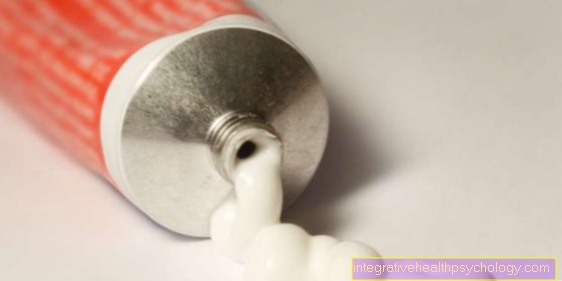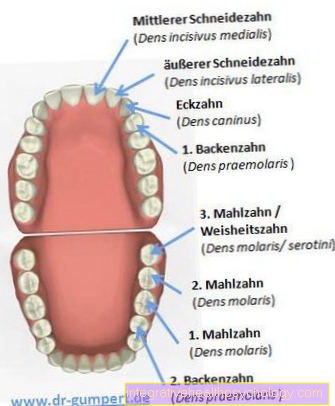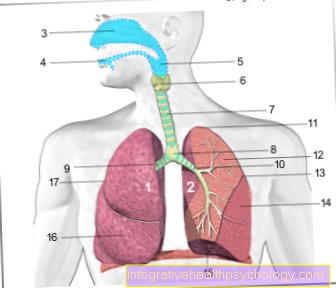Synovitis
introduction
Synovitis or synovitis is an inflammation of the inner layer of the joint capsule, the synovial membrane. This membrane, also known as the synovial membrane, lines the inner surfaces of all joint capsules, tendon sheaths and joint bursa. Here it is responsible for the production of the synovial fluid, which not only serves to dampen impacts on the joint, but also contains glucose to nourish the vascular articular cartilage. An intact synovial membrane is essential for a healthy, functional joint.
Inflammation of the inner joint skin is divided into two forms; acute and chronic synovitis. In some cases they differ greatly in their course and prognosis and therefore also in the approach to their treatment. Especially in the case of chronic synovitis, coral-like overgrowth of the membrane occurs, resulting in the destruction of articular cartilage as well as ligaments and tendons. Destruction of bony structures is also possible.
Also read the following article on this topic: Inflammation of the synovial membrane

causes
Synovitis is a major problem, especially in the context of a number of underlying diseases of the joints. Older people are often affected by synovitis, which occurs as a result of chronic wear and tear on the joint surfaces. Likewise, inflammatory processes of the synovium occur particularly in the context of rheumatoid arthritis, juvenile arthritis and psoriasis arthritis (psoariasis arthritis). Since inflammatory processes also take place in the joints in the course of lupus erythematosus (butterfly lichen), these patients often suffer from joint capsule inflammation.
On the other hand, occupational groups who mainly work in a kneeling position are often affected by synovilaitis of the knee. Tiles and cleaners are typical examples of work-related synovitis. Likewise, athletes with chronic strain on the musculoskeletal system without adequate relief phases or joint injuries that have not completely healed can become ill.
The mechanism of development is similar in all of these patient groups: especially at the transition from the joint surface to the joint capsule, progressive inflammatory processes occur, which lead to cell division and the growth of the epithelial cells of the synovium. The immigration of inflammatory cells leads to a cauliflower-like proliferation of the epithelial cells in the joint space and surrounding tissue and thereby causes the destruction of cartilage and bone tissue, as well as adjacent ligaments, tendons and other tissues.
Synovitis after knee replacement
The knee TEP is an extremely invasive procedure in which the joint capsule is completely opened and all joint surfaces are then replaced with prosthetic material. Parts of the joint capsule and the synovial membrane are removed because they have no essential function for the artificial joint. At the end of the operation, the capsule is sewn up and left in the anatomically correct place.
In the further course, a so-called "Abrasion synovitis“Arise on parts of the remaining synovial membrane. The inflamed synovial membrane can cause pain and lead to effusions and swelling of the joint. If the synovitis occurs over a long period of time, another operation to remove the joint mucous membranes may have to be performed.
You can find a lot more information under our topic: Pain after a knee prosthesis
Symptoms
The main symptoms of synovitis are the redness, warming, and swelling of the joint and pain, which occurs mainly when moving. All of these symptoms are caused by the inflamed inflammatory cells, which release enzymes and messenger substances into the joint space, so-called inflammatory mediators. Especially after acute overload, for example after physical work or a sporting competition, the disease becomes noticeable through restricted mobility and pain.
If the disease remains untreated, the inflammatory processes lead to permanent damage to cartilage and bones, which in turn leads to chronic pain.
Read also the topic: Cartilage flake
Appointment with ?

I would be happy to advise you!
Who am I?
My name is dr. Nicolas Gumpert. I am a specialist in orthopedics and the founder of .
Various television programs and print media report regularly about my work. On HR television you can see me every 6 weeks live on "Hallo Hessen".
But now enough is indicated ;-)
In order to be able to treat successfully in orthopedics, a thorough examination, diagnosis and a medical history are required.
In our very economic world in particular, there is too little time to thoroughly grasp the complex diseases of orthopedics and thus initiate targeted treatment.
I don't want to join the ranks of "quick knife pullers".
The aim of any treatment is treatment without surgery.
Which therapy achieves the best results in the long term can only be determined after looking at all of the information (Examination, X-ray, ultrasound, MRI, etc.) be assessed.
You will find me:
- Lumedis - orthopedic surgeons
Kaiserstrasse 14
60311 Frankfurt am Main
You can make an appointment here.
Unfortunately, it is currently only possible to make an appointment with private health insurers. I hope for your understanding!
For more information about myself, see Lumedis - Orthopedists.
Synovitis Score
The synovitis score is the most widely used method for evaluating the severity of synovitis. Here, the disease is assessed histologically by a pathologist, i.e. by microscopic examinations of the synovial tissue. The synovitis score is therefore a quickly available and at the same time inexpensive aid, which is of great use in the further planning of a targeted and effective therapy.
For this purpose, a biopsy of the joint capsule is performed and the tissue sample obtained is processed for microscopic examination. According to the stage of the changes in the tissue, points are awarded and then added up. This results in a total number of points from 0 to a maximum of 9 points, with more severe manifestations of the disease receiving higher scores.
It is of particular interest whether it is low-grade synovitis (0-4 points) or high-grade synovitis (5-9 points), since conclusions can be drawn about the cause of the disease from this.
Accordingly, low-grade inflammations speak more for a degenerative joint disease, such as osteoarthritis and accidental joint damage.
High-grade synovitis, on the other hand, is more likely to indicate an underlying rheumatic disease, such as rheumatoid arthritis or psoriasis.
therapy
The first step in treatment after a diagnosis of synovitis is to immobilize the affected joint or the entire limb. Regular cooling of the joint using ice packs or cold packs should be a supportive measure. The cold leads to a reflex narrowing of the vessels in the tissue with a strong blood supply due to the inflammation and thus to a decrease in the swelling. If these measures are carried out adequately, a significant reduction in symptoms can often be achieved within a few days.
Nonetheless, taking pain reliever and anti-inflammatory drugs like ibuprofen and diclofenac is essential. Apart from that, the causal underlying disease should be treated as far as possible.
If, with the help of conservative (non-surgical) approaches, no improvement in symptoms can be achieved, or if the disease occurs more frequently, surgery is advisable. Nowadays this is done in the form of a minimally invasive procedure, more precisely an arthroscopy (joint endoscopy), mostly under general anesthesia.The surgeon uses incisions that are just a few millimeters to gain access to the joint space, through which a camera and other instruments are then inserted.
The ultimate goal of this procedure is to remove the growths of the mucous membranes so that the inflammatory processes can decrease and the synovitis can subsequently heal. In severe cases, the complete removal of the synovial membrane, a so-called synovectomy, may be necessary. At the same time, joint effusions can be relieved by removing excess joint fluid, which can then be examined for its composition and the possible presence of bacteria.
What is hypertrophic synovitis?What is synovitis pigmentosa?
Synovialitis pigmentosa is another name for a so-called “giant cell tumor” of the synovial membrane.
This is a benign tumor, but it can cause swelling and effusion of the joints and tendon sheaths. Inflammatory cells give the tumor tissue a red-brown color, which is where the name “pigmentosa” comes from. The tumor develops spontaneously and often without a triggering cause. It can grow diffusely in the joint and, despite its benign nature, cause severe damage.
The affected parts of the mucous membrane can be removed in a jointoscopy. In the long term, however, a joint replacement using a prosthesis is necessary for complete healing.
You can find further information under our topic: Synovitis pigmentosa
Localization of synovitis
Synovitis in the hip joint
The hip joints are exposed to great stress in the course of a lifetime. It is therefore not surprising that in old age the hips are very often affected by degenerative changes, above all arthrosis, which are often accompanied by synovitis.
In many cases, however, treatment of inflammation of the inner joint capsule of the hip joint is difficult because the disease is often advanced and it is difficult to immobilize the joint. For this reason, the treatment here is primarily based on drug and surgical therapy.
Synovitis in the knee joint
A peculiarity of knee synovitis is its job-related occurrence. While the synovitis of other joints mainly occurs in the context of degenerative changes such as osteoarthritis or a disease of the rheumatic type, occupational groups who work in a kneeling position also suffer from synovitis of the knee. Tiles and cleaners in particular are classic examples of this.
As a result of accidents, synovial membrane growths often occur on the knee. In addition, the disease does not differ in course or treatment from other localizations.
For more information, read on: Synovitis in the knee.
Synovitis in the elbow
Synovitis in the elbow is a painful condition with significant restrictions on everyday movements.
The cause of synovial inflammation is often an unfamiliar, heavy load on the elbow. This can be the case for physical occupations but also for highly stressful sports. Bodybuilders in particular are affected by the disease, as strong force loads if performed incorrectly can lead to considerable strain on the elbow. The inflammation can cause swelling in the joint and thickening of the bursa.
The joint mucous membranes can be removed with the help of a joint mirror. If necessary, the inflamed bursa must also be surgically removed. Protection and cooling of the elbow come first in the treatment.
Synovitis in the wrist
The hands in general and the wrists in particular are affected by arthritis in almost all rheumatic patients. For this reason, synovitis is also very common here. This is already noticeable in the early stages through pain and restricted mobility. Swellings caused by synovial growths can often already be felt here.
A special phenomenon of wrist synovitis is the so-called caput ulnae syndrome. This results in tearing of the extensor tendons of the fingers as a result of destruction of the head of the elbow bone. Usually the tendon of the little finger is affected first. The consequence of the destructive changes can be the tilting of the wrist to the thumb with a significant dislocation of the hand. Finally, the late stage is often characterized by complete stiffening or great instability of the wrist (ankylosis).
All information about this topic can be found on our site Synovitis in the wrist
Synovitis in the fingers
The fingers can also be affected by uncomfortable synovitis. This is often a "Tendosynovitis“, An inflammation of the inner lining of the tendon sheaths.
There are two main causes of synovitis on the finger. On the one hand, bacterial pathogens can penetrate the soft tissue of the finger through small skin injuries and trigger an inflammation involving the tendon sheaths and mucous membranes. Furthermore, excessive strain and movement of the fingers can lead to increased irritation and trigger synovitis. Such irritation often occurs when the hands and joints are subjected to excessive exercise of new sports or other previously unfamiliar activities.
Chronic synovitis of the finger can result in complications such as a “snapping” finger, triggered by the chronic inflammation of the neighboring flexor tendons.
Synovitis in the ankle
The main symptoms of ankle synovitis, as with other locations, are pain, blockage, and swelling of the joint. It is often the result of sports injuries.
In terms of therapy and course, synovitis of the ankle does not differ from other locations. In acute therapy, cooling and immobilizing the joint, as well as taking pain relievers and anti-inflammatory drugs, are particularly important. In severe cases, surgery may be necessary.













.jpg)















